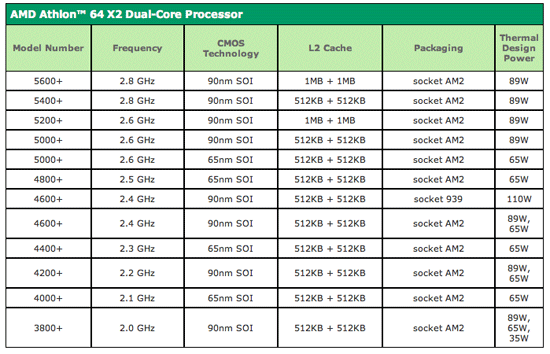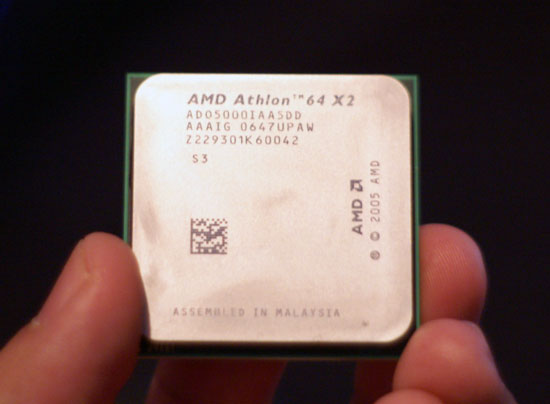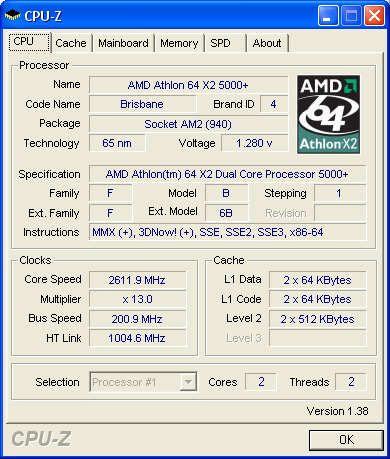AMD's 65nm Brisbane Core Previewed: The most energy efficient AMD CPU to date
by Anand Lal Shimpi on December 14, 2006 6:08 PM EST- Posted in
- CPUs
When Intel launched its Core 2 line of processors we saw AMD's performance and power advantages vanish into thin air but the comparison, at least on the power side, wasn't totally fair. Intel had been shipping desktop processors on its 65nm process for months prior to the launch of Core 2, while AMD's Athlon 64 X2s were still built on a 90nm process. We had no way of telling how much of Intel's power advantage was due to a more efficient architecture or simply smaller, cooler running transistors. Up to now, AMD has been penalized twice in all Core 2 vs. Athlon 64 X2 comparisons; AMD's new micro-architecture won't debut until next year and neither will 65nm in any great quantities.
Technically in-line with roadmaps, AMD just introduced and announced shipment of its first 65nm cores: codenamed Brisbane. Availability is another story entirely, as it's looking like we won't see any real quantities of these things until Q1 2007. Right now AMD's Brisbane chips are strictly OEM only and AMD wasn't able to give us an indication of when to expect retail/channel availability. Of course we wouldn't be talking about this today if we didn't have a chip, which we do, but for all intents and purposes you can consider this a preview of what to expect in the new year from AMD's first 65nm chips.
AMD announced its Brisbane lineup earlier this month, the chips and basic specs are listed below:

As you can expect, AMD is pricing the 65nm chips in line with its 90nm offerings to encourage the transition. Die size and TDP have both gone down to 126 mm^2 and 65W across the line. As AMD improves its 65nm SOI process you can expect to see even lower wattage parts, but for now all of the 65nm chips are rated at 65W TDP.
Transistor count remains unchanged at 154M as there is no new functionality or cache introduced with the move to 65nm. Once again, we will have to wait until around the middle of 2007 before we'll see any major changes to AMD's architecture.

The chip we received was AMD's 65nm Athlon 64 X2 5000+ and from the outside, it looks just like a normal X2. The only way to tell that this is a 65nm chip is by looking at the OPN.

Armed with the chip and its $301 price point we set out to compare its performance, power consumption and power efficiency to AMD's other 90nm CPUs and the closest price competitor from Intel: the Core 2 Duo E6600 priced at $316.










63 Comments
View All Comments
Live - Thursday, December 14, 2006 - link
It does not use more power then any other chip except the 90nm X2 5000+. Where did you get that from? Did you read the article?Stereodude - Thursday, December 14, 2006 - link
Yes, I read the article. Excluding the C2D it uses the 2nd most amount of power, basically tied with the 65W 4600+.smitty3268 - Thursday, December 14, 2006 - link
Not all the power that goes into a chip is released as heat. The heat is basically wasted power that "leaks." So if a chip can get more useful work out of the same amount of power then the amount of heat released would decrease even while power consumption remained steady.I'm not an expert, but I believe a lot of the special new process techniques we always here about (like strained silicon) basically just reduce the amount of wasted energy. Am I right here?
Stereodude - Thursday, December 14, 2006 - link
Sorry, but that's incorrect. All the power is turned into heat. The power can't be going anywhere else. Power in = Power out.It's not like a LED where you get some energy out as light, or a motor where you get mechanical energy out of it in addition to heat.
finalfan - Thursday, December 14, 2006 - link
If all the power can be turned into heat then it will be the most efficient heater the human being ever built. And even greater, you get all the computation done for free. Could you believe that?Stereodude - Thursday, December 14, 2006 - link
Where else is the energy going if it isn't getting turned into heat? You apparently don't have any idea how the transistors in a processor work.splines - Thursday, December 14, 2006 - link
You apparently don't have any idea about basic thermodynamics.If the processor released all of its energy in heat, it'd be the world's most efficient space heater.
You have forgotten a few little points, like that work is done by a processor (wouldn't be much point otherwise). Transistors are switched, mostly, however the IC itself can expand and contract, as well as the packaging material. The heat generated by a CPU is because of the resistance inherent to the circuits. All of the above is considered energy expended (or, more properly, changed in state).
In other words, don't go around insulting people's intelligence when you don't know yourself what you're on about.
Stereodude - Thursday, December 14, 2006 - link
I'm betting only one of us has an Electrical Engineering degree, and guess what... You're not the one with it.The work being done by the CPU is what makes the heat. The transistors themselves create heat because they consume power, and a lot of it, to switch from one state to another at high speeds.
I will say it again since you still don't get it, though it probably won't help. Energy is conserved. Electrical energy goes in, and heat comes out. The thermal expansion and contraction of the part isn't work. It's a side effect of the heat being product when the transistors consume electrical power by switching and make heat.
slayerized - Friday, December 15, 2006 - link
Thermodynamics 101- First law of thermodynamics: “Energy can neither be created nor destroyed, it can only be converted from one form to another” (Power --> Heat)smitty3268 - Friday, December 15, 2006 - link
I think everyone here knows that, the issue is that current -> heat is not the only type of transformation that can occur. If it was then anything electric wouldn't be able to do anything at all except create heat, and obviously that isn't true.